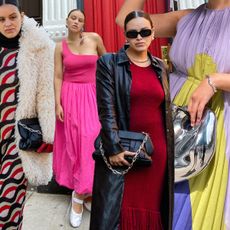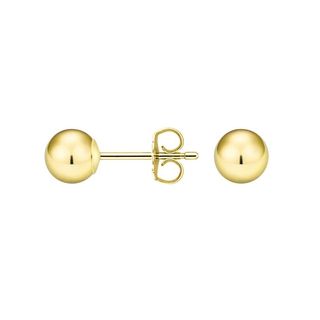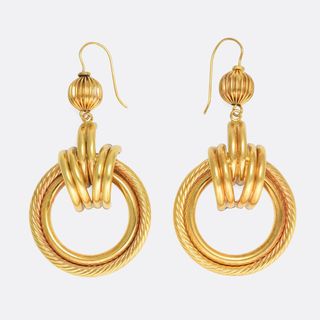Is Your Favourite Jewellery Wreaking Havoc on the Environment?
This feature is dedicated to our #NoChangeNoFuture initiative. From the Women’s March, to Australia voting yes to same sex marriage, and the #MeToo movement, 2017 taught us to look beyond ourselves and come together as a collective of powerful women who are writing our own history. Join us as we commit to being the change we want to see in 2018. Because without change, there is no future.

No one likes to be the bearer of bad news, but in light of our focus on the damage fast fashion is doing to the environment, there’s another topic that needs addressing: Jewellery. While it serves as a styling and a personality-definer of sorts, jewellery is something that many of us hold dearly to our hearts—hence the big importance placed on engagement rings. And though a fancy gold signet ring may strike the perfect balance between chic and sophisticated, there is another side to the jewellery worth considering.
Particularly when it comes to gold, there are environmental problems associated with the extraction of the precious metal that goes into crafting some of our favourite pieces. As time goes on, the amount of easily-available gold is diminishing, despite the growing demand for it. This means that as gold is gaining popularity, it’s also becoming far more difficult to obtain. Consequently, mining is becoming more extreme, and the damage isn’t simply caused by the energy required to physically move the earth in order to reach the metal.
While a lot of energy does go into gold extraction, a number of toxins also come into play during the process. As The Epoch Times reports, “An average large-scale gold mine uses 1,900 tons [1,723,651 kilograms] of cyanide annually” along with “arsenic and other chemicals” which remove other materials. The result? Toxic drainage, which according to Slate, is “probably the biggest environmental concern associated with gold mining.” This admittedly makes mining of gold look bad enough already, but the processing operations subsequently involved further add to it.
“Large-scale gold operations often start processing ore by roasting it,”, Slate shares. As the ore is roasted, “the unwanted side effect of shooting a lot of mercury into the atmosphere” often occurs. Needless to say, the consequences are dire. “The resulting erosion clogs streams and rivers and can eventually taint marine ecosystems” Smithsonian Magazine reports. “Exposing the deep earth to air and water also causes chemical reactions that produce sulfuric acid, which can leak into drainage systems. Air quality is also compromised by gold mining, which releases hundreds of tons of airborne elemental mercury every year.”
So when faced with these kinds of facts, what can we do? While one option would be to only buy gold jewellery that is“sustainably mined”, there are other alternatives. Because of the scarcity of gold and the process required to obtain it, buying either vintage or jewellery crafted from recycled metals is an option. Slate suggests that “the best way for you to mitigate the impacts of gold mining might be to make a personal pledge to keep gold in circulation”. According to Smithsonian Magazine, “About 165,000 metric tons [165 million kilos] of gold have been mined in all of human history. Most of this gold is still in circulation—and a growing number of jewellers are making use of this material.”
All things considered, there is enough gold to go around; but perhaps the demand just isn’t there yet. At the pace we’re going, however, a change needs to happen—and soon. As the years go by, mining gold will only become increasingly difficult (and increasingly damaging to our planet). By shopping brands that use recycled materials, or opting for vintage pieces, we can begin to turn the tides away from mining and welcome a new era of gold jewellery. Tiffany & Co. is just one brand focusing on ethical practices and mining.
After all, when investing in a special jewellery piece, monetary cost is often considered… but what about the ethical cost? If we turn the tables now, we can encourage more brands to use recycled gold in their designs. Imagine what it will be like once we can all look and feel good in our favourite jewellery.
Related: The Clever Way This Local Brand Is Helping the Environment
Shop some of our favourite vintage and recycled gold jewellery:

This vintage signet ring even has a cute hidden message.

This bracelet is delicate enough to wear every day.

-
 Reformation Finally Launched Swimwear, and the Collection Is Pure Elegance
Reformation Finally Launched Swimwear, and the Collection Is Pure Elegance*Orders every suit.*
By Eliza Huber
-
 All My Outfits Right Now Are Built Around These 5 Items
All My Outfits Right Now Are Built Around These 5 ItemsI plan to transition these right into spring.
By Caitlin Burnett
-
 If You Have 60 Seconds to Get Dressed, Just Wear One of These Easy Outfits
If You Have 60 Seconds to Get Dressed, Just Wear One of These Easy OutfitsSet your timer.
By Aemilia Madden
-
 16 Classic Finds That Are Key to Building Your Perfect Capsule Wardrobe
16 Classic Finds That Are Key to Building Your Perfect Capsule WardrobeThis brand is a gem.
By Raina Mendonça
-
 I Started My Day Like Akilah Releford Gould for a Week: 5 Habits I'm Keeping
I Started My Day Like Akilah Releford Gould for a Week: 5 Habits I'm KeepingSuch a game changer.
By Maya Thomas
-
 16 Classic Winter Fashion Finds That Will Stand the Test of Time
16 Classic Winter Fashion Finds That Will Stand the Test of TimeThese are winners.
By Raina Mendonça
-
 I Haven't Spent More Than $150 on Clothing in Six Months—Here's How I Did It
I Haven't Spent More Than $150 on Clothing in Six Months—Here's How I Did ItYes, really.
By Jasmine Fox-Suliaman
-
 Feel and Look Good: Shop These Supermodel-Approved, Sustainable Summer Picks
Feel and Look Good: Shop These Supermodel-Approved, Sustainable Summer PicksSlow fashion is here to stay.
By Raina Mendonça




